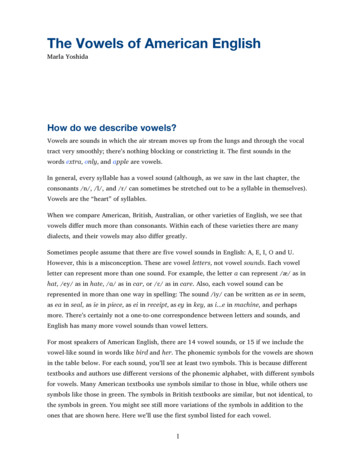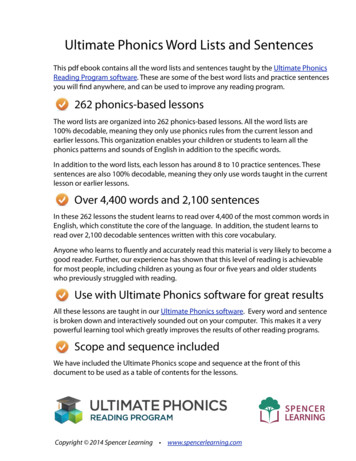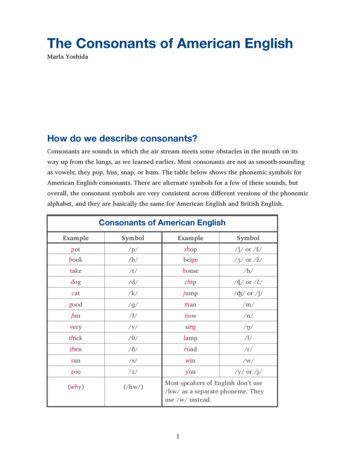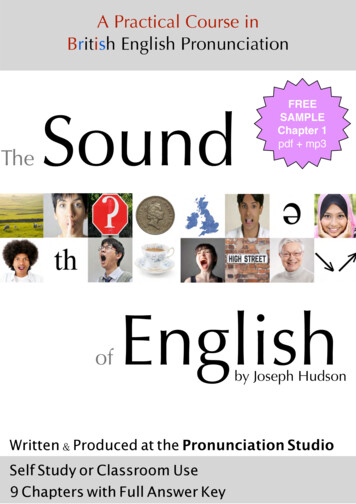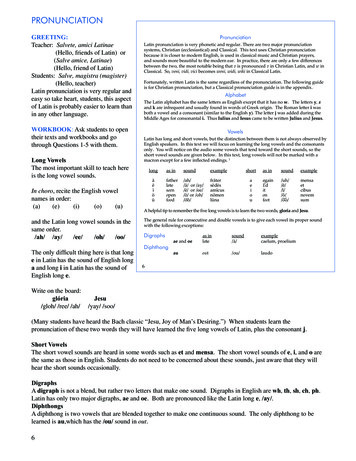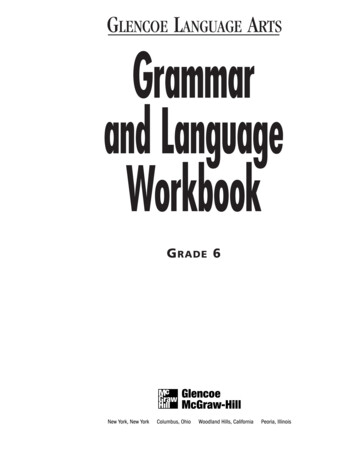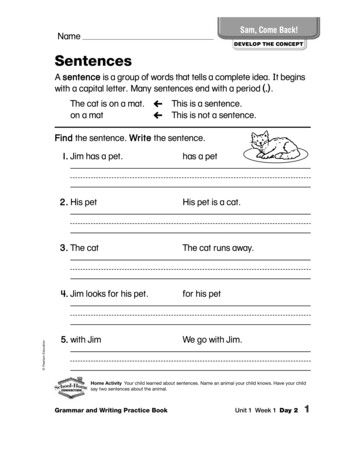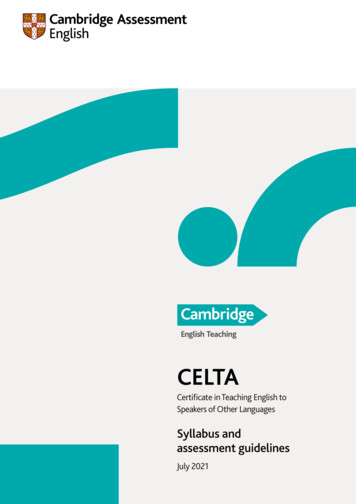
Transcription
Short Vowel WordsAnd Sentenceseauio
Short Vowel SoundsAaEeIiOoUuSight Word ReviewaisasAhiszIzzhaszwaszCitydunSoEntire contents 2010 By Kathryn J. Davis7223 Cedar Lane DriveGermantown, TN 38138(901) 737-4466All rights reserved.ReadingPermission is hereby granted to teachers, parents, and tutors to reproducestudent materials in this book for individual or classroom use. Permission isgranted for school-wide reproduction of materials. Commercial reproduction isprohibited.Printed in the United States of America
Table of ContentsHow to use this book . 4The Robot Game . 6Putting Two Sounds Together Using Plastic Letters . 8Sound Blending - Decoding Two Sounds . 11The Blueberry and Raspberry Games . 14Using Plastic Letters To Spell Three Letter Words . 15Learning To Separate Words Into Sounds . 16Short A WordsShort a words, part 1 (continuous consonants at the beginning) . 18Short a words, part 2 (stopped consonants at the beginning) . 20Sight word: a . 22Sight word: has. 26Sight word: was . 30Short I WordsShort i words, part 1 (continuous consonants at the beginning) . 34Short i words, part 2 (stopped consonants at the beginning). 36Sight word: I. 38Sight word: is . 42Sight word: his . 44Statements . 46Questions . 48Short O WordsShort o words, part 1 (continuous consonants at the beginning) . 50Short o words, part 2 (stopped consonants at the beginning) . 52Short U WordsShort u words, part 1 (continuous consonants at the beginning) . 62Short u words, part 2 (stopped consonant at the beginning). 64Suffix study: s with verbs . 72Short E WordsShort e words, part 1 (continuous consonants at the beginning) . 74Short e words, part 2 (stopped consonants at the beginning) . 76Suffix study: s with verbs . 84Suffix study: s with nouns . 90Suffix study: using 's . 96Alphabet Chart . 100Consonant Chart for sound blending activity . 104 2011 by Kathryn J. Davis3Short Vowel Words And Sentences
How To Use This Book1.Use the sound story at www.soundcityreading.com to introduce the sound pictures.These pictures provide a visual cue to remind the student of the sound for each letter.2.Students should be able to recognize and give the sounds for the letters of thealphabet. Use the alphabet chart to review the letter sounds.3.In this booklet, students will read words and sentences with each short vowel sound.The vowel being studied is shown at the top of the page along with the related soundpicture and a key word beginning with that sound. Have students identify this vowelsound before reading each page.4.When learning a new set of words, students will see a picture page beside a page ofwords. The pictures and words are not in the same order. This allows the teacher toplay the Robot Game with the students who are getting ready to read the words for thefirst time. See the instructions in this book.5.After playing the Robot Game, students will practice decoding (sounding out) new wordsin two columns. In the left column, the words are separated, to show the separatesound units within the word. To read this column, students should put a finger underthe first letter, say the sound, slide their fingers to the next letter, say the sound,slide to the next letter, and say the sound. Then students should point to the sameword in the right hand column, and pronounce it smoothly. Beginners may prefer to readthe first column only. After reading each word, students may to point to the matchingpicture.6.After reading all the words for each short vowel section, students will read sentencescontaining short vowel words. It is not necessary for students to guess. If a studenthas trouble with a word, help him to say the sounds from left to right. Also, remindstudents to think about the other words in the sentence and anticipate what wordswould make sense.7.Each set of sentences is shown in two different fonts. The vowels are color coded inthe first set, making the material easier to read. All of the letters are black in thesecond set. Students should practice until they can read both types of printcomfortably.8.Explain the use of periods and question marks.9.There are several pages showing the use of s with verbs and nouns, and the use of ’sto show possession. Explain the use of these suffixes and have the student read thepages. 2011 by Kathryn J. Davis4Short Vowel Words And Sentences
10.An umbrella over a vowel is a signal to use the u/umbrella sound (short u sound) forthat vowel, instead of its usual sound.11.Sight words have parts that can not be sounded out in the usual way. On each sightword page, show the student how to pronounce the sight words, and have the studentread the sentences. After finishing this booklet, students should be able to read allof the sight words on the inside of the front cover.12.The short vowel words are taught in this order: short a words, short i words, short owords, short u words, short e words. Each set of these is divided into two groups.The first group of words starts with continuous consonants. The second group ofwords starts with stopped consonants.13.When you pronounce a continuous consonant, it is possible to hold the sound for aperiod of time. This makes it much easier for a student to connect the firstconsonant sound in the word to the vowel sound that comes after it. I use theseconsonants in the first group: f, h, l, m, n, qu, r, s, v, w, x, y, and z. (When youpronounce the consonants qu and x, you can actually hear two parts to the sound. Theletter qu sounds like /kw/, and the letter x sounds like /ks/. I include these lettersin the continuous consonants since the second part of the sound can be held.)14.Stopped consonants cannot be held. The sound disappears after you pronounce it. Iuse these stopped consonants: b, c, d, g, j, k, p, and t. These words are harder forbeginners to read because it is more difficult to connect the sound of the firstconsonant and the following vowel smoothly.15.I’ve put words that begin with the same consonant together on the page. Forexample, the words can, cat, cab, and cap will appear together. This repetition helpsthe student master oral blending of the first consonant and the following vowel. Italso helps the student learn to watch carefully and be aware of the endingconsonants, since they change from one word to the next.16.Beginning readers master decoding skills at different rates. It is important forstudents to take ownership over the need to practice reading and rereading thematerial until it can be read smoothly, with good expression. Many students havedifficulty getting started, but go on to master the material very well.17.If a student has difficulty connecting the separate letter sounds together to formwords, play the games suggested in this book on a regular basis. The blueberry andraspberry games will be available at www.soundcityreading.com.18.A workbook is available for written practice with short vowel words. 2011 by Kathryn J. Davis5Short Vowel Words And Sentences
c.a.tPlaying The Robot Game:Connecting SoundsTo Make WordsUse the picture pages in this book to play a guessing game to prepare studentsto read new words. The pictures are on the left side, and the new words to read areon the right side. The pictures and words match, but they are not in the same order.This makes it easier to play the game. During the game, the teacher will say the words"like a robot," by pronouncing each sound in the word separately.This activity is ideal to help the student become accustomed to the idea of putting sounds together to form words. It is ideal for beginners or students who are having difficulty learning to read.Part One - Finding the Pictures1. The student looks at the pictures. The teacher looks at the words.2. The teacher says the sounds in the first word, going from left to right, with apause between each sound. For example, if the word is fan, the teacher would say"f.a.n." Don't point to the letters, just say the sounds. Be sure each soundis completely separate. For example, don't say "fa.n" or "f.an." Also, be careful not to add the "uh" sound to the consonants, "fuh.a.nuh." Be sure to pronounce double letters as a single sound, for example "m.i.ss."3. The student looks at all of the pictures, finds the picture of the fan, points to it,and says the word in the normal way (not with separated sounds).4. The teacher says the sounds for the next word, and then the remaining words, oneat a time, until all have been completed.5. The student responds in the same way each time, finding the picture, pointing to it,and saying the word. 2011 by Kathryn J. Davis6Short Vowel Words And Sentences
Part Two - Finding the Words1. This time, both the student and the teacher look at the words.2. The teacher says each word "like a robot," just as before, except this time goesout of order, selecting words randomly on the page.3. The student looks at all of the words on the page, listens to the sounds, and findsthe matching word. He must look carefully to find the word with the correct beginning, middle, and ending sound. Then the student points to the word and says itin the regular way. If the student tries to say the separate sounds, remind him to"say it fast."CommentsThis exercise introduces new vocabulary to the students without the burden ofhaving to decode new words, allowing them to focus on meaning. It also helps students learn to hear the separate sounds in each word, and then stick them togetherto reassemble the word. This is an important skill that develops a student's ability tospell and decode new words.(Note: The pages from the pdf file for this book will be available atwww.soundcityreading.com. They can be displayed on a large screen using a projector.The game can be played with the entire class from the screen.) 2011 by Kathryn J. Davis7Short Vowel Words And Sentences
Putting Two Sounds TogetherUsing Plastic LettersThis activity is ideal to help the student become accustomed to the idea ofputting sounds together. It is ideal for beginners or students who are havingdifficulty learning to read.MaterialsYou will need some system of small, moveable alphabet letters. Use lower caseletters. You can use small plastic letters. Or you can write letters on small pieces ofblank index cards, on small cubes, or on one inch square tiles. Write one letter of thealphabet on each card, cube, or tile. Store the items in a small box or bag.Setting Up the ActivityTo set up the activity, select one vowel and about six or more consonants. Pickout letters that have been taught. Cut a piece of construction paper in halflengthwise, and place both paper strips in front of the student, one above the other.Put the consonants in a row on the top strip and the vowel on the bottom strip. Forexample, you might use the vowel i and consonants t, h, l, n, w, and b.To Do the ActivityThe teacher will dictate several vowel-consonant combinations, such as it, il,in, etc. Each combination will have two sounds. One sound will be a vowel sound. Theother sound will be a consonant sound. The letter to show the vowel sound will bealready in place on the lower strip of construction paper. The student is to listen forthe consonant sound, select the correct consonant letter, and put it beside the vowel.Then the student pronounces the letter combination orally.Explain to the student that you will be saying parts of words, not real words.We can call these "silly sounds." Explain that being able to spell these parts will helpthem learn to spell and read real words.Be sure to use the short vowel sounds when you do this exercise: a/ant, e/egg,i/in, o/ox, u/up.You can see a typical sequence on the next page. 2011 by Kathryn J. Davis8Short Vowel Words And Sentences
Teacher: “Show me ib.”Student: Selects b and places it immediately to the right of the i, then blends thesounds together from left to right, without a break between sounds: “ib.”Teacher: “Show me il.”Student: Puts b back in line above the i, selects l, and places it to the right of i. Blendsthe sounds together from left to right: il. (Notice you are not spelling the word ill, justthe work chunk il.)Teacher: “Show me in.”Student: Puts b back in line above the i, selects n, and places it to the right of the i.Says in. (This just happens to be a real word. The student may or may not notice this.)Teacher: “Show me it.The teacher and student continue in the same way until all of the possible vowelconsonant combinations have been done. You won’t use h or w after the i, since ih andiw are difficult to pronounce and these combinations are not normally seen in words.You will use the letters h and w shortly as beginning sounds are paired with i.Next do the same activity, but this time say letter combinations that have theconsonant sound first. Show me hi. Show me bi, ti, li, ni, etc. Don't forget to use theshort vowel sound for all letter combinations. 2011 by Kathryn J. Davis9Short Vowel Words And Sentences
This process of building two-letter sound combinations helps students "break thecode" and understand that speech is made up of smaller sounds. Instead of startingwith three-letter words, its much easier for students to just concentrate on twosounds at a time. Being able to see the letters and physically move them as they hearthe combined sounds and build them opens the door to a real understanding of thestructure of words.CommentI worked with my niece years ago when she was in kindergarten. She workedhard to learn her alphabet letters. At first she couldn’t remember which was whichand couldn’t remember the sounds. I wrote the sound story (available on the website)for her, and using posters with the letters and sound pictures, she learned thoseletters like a pro. But she still did not grasp the concept that the letter sounds couldbe put together to form meaningful words. One day, as I was trying to teach her tobuild three letter words with plastic letters with no luck, we invented this activitytogether. Doing just two sounds at a time made a huge difference. The light bulb wenton during the lesson. From then on she made steady progress, and went on to makestraight A’s in first grade. She is now doing well in her Honor’s reading classes inmiddle school, and most important, she loves to read. 2011 by Kathryn J. Davis10Short Vowel Words And Sentences
Sound Blending - Decoding Two SoundsAfter the student has practiced putting two sounds together using plasticletters, you can do this activity to teach the reverse skill. This activity is morechallenging, since the student is going from symbol to sound instead of sound tosymbol. The student must look at a pair of letters and say both sounds, sliding thesounds together smoothly. The student learns to connect symbols with speech.MaterialsTo do this exercise, you can use the sound blending materials available on thissite, or create your own.You’ll need two separate cards for each vowel, like the i cards shown below.You will use these cards with two columns of consonants. These materials use largeprint so they can be used with a group.Print the two consonant columns on white cardstock. I print the vowels oncolored cardstock, using red for a, light green for e, light purple for i, orange for o,light blue for u. Put the two consonant columns on an easel or clip to a pocket chartor chalkboard.Setting Up the ActivityYou will use two vowel cards and the consonant strips. You will hold a vowel card tothe right or left of each consonant and move the card down the column.To Do the ActivityTake the vowel you want to work with, and slide it down one side of thecolumn. Students will blend the sounds for each letter pair aloud. You can go downthe left side first and then the right, or the other way around. If you are using ion the left side first, the student would watch carefully as you move the i from oneletter to the next and say, “ib, ic, id, if, ig, (skip h), ij, ik, il, im, in, ip, (skip qu and r),is, it, iv, (skip w), ix, (skip y), iz.” Then, as you move the other vowel card down theright side of each column, the student would say, “bi, (skip c), di, fi, gi, hi, ji, ki, li,mi, ni, pi, qui, ri, si, ti, vi, wi, (skip x), yi, zi.” After students master the processwith one short vowel, you can repeat the process for the other vowels. Rememberto use just the short vowel sounds for now. 2011 by Kathryn J. Davis11Short Vowel Words And Sentences
i bpcqudrfsgthvjwkxlymzinThe task is more difficult for beginners than you might think. Somestudents catch on quickly, and others find this process quite challenging. If thestudent does not catch on quickly, don’t give up. If necessary, model eachcombination for the student by pronouncing it clearly, and have the student repeat.Regular practice will bring more self-assurance for the student. It may take daysof practice before the student is able to put the sounds together independently.Even though the student is only blending two sounds together, this exerciseprepares students to read three letter words. If a student can’t put two lettersounds together, it will be impossible to put three or more sounds together to reada word. This ability to stick letter sounds together to form words when reading,and the reverse ability, to separate the individual sounds in whole words whenspelling, is the foundation for developing the ability to decode quickly andconfidently. 2011 by Kathryn J. Davis12Short Vowel Words And Sentences
CommentsAfter a move to a new city, I spent some time tutoring before going back to theclassroom full time. I volunteered to work with students in my cousin’s first gradeclass. She gave me four to six students to teach in a small group for about an hourat a time. I was ready to teach them to read short vowel words, but found thatwas way beyond what they were able to do. We had to start with beginning andending sounds. I was tutoring a little girl at my house, with the same problem. Oneday I devised this activity, and she responded well to it, so I brought it to schoolto work with my cousin’s group. It was so difficult for them that we worked at itfor several lessons before they could do it themselves. It was so hard for thosechildren that I asked the school speech teacher if it was appropriate to use withthem, and she approved. After the students mastered this activity, we went on toread three letter short-vowel words, and they were able to decode themcomfortably. We played a lot of games decoding three letter short vowel words.By the end of the year they had improved dramatically, and were learning twoletter phonogram patterns and reading the related sentences and stories. 2011 by Kathryn J. Davis13Short Vowel Words And Sentences
The Blueberry and Raspberry GamesAfter the student has learned to pronounce vowel-consonant and consonant-vowelcombinations (such as ab, ac, ad, and ba, ca, da) in sound blending exercise two, youcan play this game.Setting Up: Small blue circles (blueberries) or purple circles (raspberries) withvarious vowel-consonant and consonant-vowel combinations are used in this activity.You can use the patterns at Sound City Reading or make your own. A page with theoutline of a blueberry bush is given to each student. The page has a number ofcircles on the bush. Before starting the game, cover these circles with theblueberries or raspberries, letter side up.How To Play:Students take turns “picking” a blueberry from their bush. Ifthey can pronounce the vowel-consonant or consonant-vowel combination correctly,they may place it to the side. If they cannot, the teacher should model, all thestudents repeat, and the blueberry is placed back on the bush. The first person topick all of his blueberries is the winner.Comments: I always remind children when working with two-sound combinations thatthey are not real words. We call them “silly sounds.” I tell the students thatlearning to pronounce these silly sounds will help them be able to read real acbaBlueberry Game 2011 by Kathryn J. DavisRaspberry Game14Short Vowel Words And Sentences
Using Plastic Letters To Spell Three Letter WordsThis activity works well with one to six students, or even a whole class if you haveenough sets of letters. Instead of using the whole alphabet at one time, each student willtake about six or eight letters to work with, designated by the teacher. Students spellwords dictated by the teacher with the letters. They do not write the words on paper, whichallows the spelling to proceed rapidly from one word to the next.Make a list ahead of time of the words you want to teach. Then list all of the lettersthat will be needed.Have the students sit around a table or at their desks. Ahead of time, cut sheets ofconstruction paper lengthwise to form two pieces. Each student takes two pieces and placesone above the other in front of them on the table. The top sheet is the "letter bank." Thebottom sheet is the spelling area.Give each student a box with two each of all the alphabet letters. Say the sound ofeach letter the students will need, one at a time. When they hear each sound, studentsshould find the letter needed and place it on the top sheet of construction paper. Explain tothe students that this is their letter bank. When all the needed letters have been placed inthe letter bank, you’re ready to begin.Say each word slowly and distinctly and coach the students to listen for each soundand place the letters accordingly from left to right. Model as needed. Each student willselect the letters needed from his own "letter bank," and spell the word in the spelling area.Check each student’s work and have them listen again and correct as needed. Have studentsplace the letters back into their letter banks before dictating another word.After the students become comfortable with the process, go through a number ofwords as quickly as the students can spell them.Sometimes, have the students leave a word that they spelled in their spelling area,and ask them to change one letter to create a new word. For example, if the student hasspelled cat, say, "Change just the beginning letter to make the word sat." Or say, "Changethe last letter to make the word cap." Or say, "Change the middle letter to make the wordcut." Soon, the students won't need to be cued. Just say a string of words as follows, oneat a time, and have students replace or remove letters as needed to spell the word: cat, can,fan, fax, tax, ax, ox, box.This activity greatly enhances the student's phonemic awareness. He is matchingletters with the sounds he hears in words. He is learning to sequence, add, remove, andsubstitute sounds in known words to make new words.Note: Before you do this exercise, first be surethe students can do the two-letter exercise withplastic letters, as described on a previous page. 2011 by Kathryn J. Davis15Short Vowel Words And Sentences
Learning To Separate Words Into Sounds(Preparation For Spelling)Materials:Use any of the picture pages in this book that are used to introducethe short vowel words. This is strictly a sound game; you won't useany letters. You’ll need three small objects. Colored cubes or teddybear counters are available from school supply stores. If these arenot available, you could use other items, such as buttons, dried beans,bottle caps, etc. Small slips of paper about one inch square will work,too. For three-sound words, I like to use three different colors, linedup from left to right in this order - green, yellow, and red. I talkabout the colors on a stoplight with the student. Green means go,yellow means slow down, and red means stop. When you work with twosound words, use only two of the objects.To do the activity:The teacher points to a picture. Tell the student the word if hedoesn’t recognize the picture. Show the student how to break theword apart into separate sounds. Say each sound separately. As yousay each sound, push a cube forward about an inch, going from left toright. Each cube will represent a sound. Have the student repeat theprocess with the same word. Be sure the sounds are completelyseparate. For example, cat should be c.a.t, not ca.t, and notc.at. Continue in the same way for each picture. The goal is for thestudent to look at a picture, move the cubes, and separate the wordinto distinct sounds without help from you. Be sure to explain themeanings of any unfamiliar words. 2011 by Kathryn J. Davis16Short Vowel Words And Sentences
c.a.t 2011 by Kathryn J. Davis17Short Vowel Words And Sentences
A.aB.C.D.E.F.G.H.I.J. 2011 by Kathryn J. Davis18Short Vowel Words And Sentences
a1.fnfan2.m a pmap3.m a nman4.s a tsat5.s a dsad6.h a that7.h a dhad8.n a pnap9.r a nrana ddadd 10. 2011 by Kathryn J. Davisa 19Short Vowel Words And Sentences
A.aB.C.D.E.F.G.H.I.J. 2011 by Kathryn J. Davis20Short Vowel Words And Sentences
a1.c a ncan2.c a tcat3.p a npan4.p a sspass5.b a dbad6.b a tbat7.g a sgas8.d a ddad9.j a mjam10.t a gtag 2011 by Kathryn J. Davis21Short Vowel Words And Sentences
AaSightWordsA manA fanA vana rama hata sax 2011 by Kathryn J. Davis22Short Vowel Words And Sentences
AaAmanAfanAvanaramahatasax 2011 by Kathryn J. Davis23SightWordsShort Vowel Words And Sentences
AaSightWords1.A man ran.2.A rat sat.3.A ram ran.4.A man had a hat.5.Sam ran a lap.6.Max had a nap. 2011 by Kathryn J. Davis24Short Vowel Words And Sentences
AaSightWords1.A man ran.2.A rat sat.3.A ram ran.4.A man had a hat.5.Sam ran a lap.6.Max had a nap. 2011 by Kathryn J. Davis25Short Vowel Words And Sentences
zhasSightWords1.A man has an ax.2.Sam has a sax.3.A man has a van.4.Nan has a fan.5.A man has a hat. 2011 by Kathryn J. Davis26Short Vowel Words And Sentences
zhasSightWords1.A man has an ax.2.Sam has a sax.3.A man has a van.4.Nan has a fan.5.A man has a hat. 2011 by Kathryn J. Davis27Short Vowel Words And Sentences
zhas1.Pam has a pan.2.Dan has a cat.3.Pat has a bat.4.Sam has a cap.5.Sam has a gap. 2011 by Kathryn J. Davis28SightWordsShort Vowel Words And Sentences
zhasSightWords1.Pam has a pan.2.Dan has a cat.3.Pat has a bat.4.Sam has a cap.5.Sam has a gap. 2011 by Kathryn J. Davis29Short Vowel Words And Sentences
zwasSightWords1.Max was mad.2.Sam was sad.3.Nan was at a lab.4.A cat was fat. 2011 by Kathryn J. Davis30Short Vowel Words And Sentences
zwasSightWords1.Max was mad.2.Sam was sad.3.Nan was at a lab.4.A cat was fat. 2011 by Kathryn J. Davis31Short Vowel Words And Sentences
zwas1.Dan was sad.2.A rat was fat.3.A cat was bad.4.Dad was mad. 2011 by Kathryn J. Davis32SightWordsShort Vowel Words And Sentences
zwas1.Dan was sad.2.A rat was fat.3.A cat was bad.4.Dad was mad. 2011 by Kathryn J. Davis33SightWordsShort Vowel Words And Sentences
A.iB.C.D.E.F.G.H.I.J. 2011 by Kathryn J. Davis34Short Vowel Words And Sentences
i1.s i tsit2.s i xsix3.h i llhill4.h i thit5.h i mhim6.w i nwin7.f i llfill8.mmissi ss9.i nin10.i tit 2011 by Kathryn J. Davis35Short Vowel Words And Sentences
A.iB.C.D.E.F.G.H.I.J. 2011 by Kathryn J. Davis36Short Vowel Words And Sentences
i1.b i gbig2.b i tbit3.b i llbill4.k i dkid5.k i sskiss6.p i npin7.p i gpig8.p i llpill9.t i ptip10.d i gdig 2011 by Kathryn J. Davis37Short Vowel Words And Sentences
ISightWords1.I win.2.I can mix it.3.I miss him.4.I hid.5.I will sip it.6.I lit it. 2011 by Kathryn J. Davis38Short Vowel Words And Sentences
ISightWords1.I win.2.I can mix it.3.I miss him.4.I hid.5.I will sip it.6.I lit it. 2011 by Kathryn J. Davis39Short Vowel Words And Sentences
ISightWords1.I can zip it.2.I will hit it.3.I can dig it.4.I am a kid.5.I am a pig. 2011 by Kathryn J. Davis40Short Vowel Words And Sentences
ISightWords1.I can zip it.2.I will hit it.3.I can dig it.4.I am a kid.5.I am a pig. 2011 by Kathryn J. Davis41Short Vowel Words And Sentences
zisSightWords1.Jan is ill.2.Dan is six.3.Pam is at a dam.4.A man is in a cab.5.It is bad.6.Jill is a
12. The short vowel words are taught in this order: short a words, short i words, short o words, short u words, short e words. Each set of these is divided into two groups. The first group of words starts with continuous consonants. The
